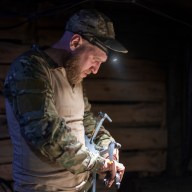 Amanda Berry and Gina DeJesus.
Amanda Berry and Gina DeJesus.
Credit: YouTube screengrab
The city of Cleveland remains in a state of disbelief Tuesday after news that three missing young women have all been found alive more than 10 years after their disappearances.
Amanda Berry, Gina DeJesus and Michele Knight all seemed to vanish without a trace in separate cases that plagued the city’s police and media for years. Now, after all three were found in a house not far from where each of them disappeared, the people closest to the cases can’t wrap their minds around how something like this could happen — and go undetected for so long.
Amanda Berry, frantic and desperate to escape, was able to flag down a neighbor Monday evening and call 911, finally free from the home where she and the other young women had been held captive since their abductions. Inside the house, police found DeJesus and Knight, and a 6-year-old girl, believed to be the daughter of Berry — all of them in good health. [embedgallery id=146543] 52-year-old Ariel Castro and his two brothers are now in custody awaiting charges.
Dorian Barrett and Duane Pohlman, investigative journalists formerly with the special projects department at WEWS in Cleveland, spent months working leads in the disappearance of Berry, who was last seen in 2003 at age 16, and Gina DeJesus, who disappeared in 2004 at age 14. They interviewed family members, combed the streets of Cleveland for a car matching the initial description and visited Amanda Berry’s bedroom in her family’s home.
Barrett describes hearing that the unsolved mystery, which consumed her thoughts as a journalist for so long, had finally come to a close — and with an ending she truly never expected.
“I don’t think the goosebumps on my skin have gone away since I heard the news,” Barrett told Metro. “I am absolutely stunned. I am so happy they were found. I feel a lot of emotions right now. It’s hard not to get choked up about these girls.”
Pohlman, who now works at WLKY in Louisville, Ky., had always hoped for closure in the case, but had expected it long before Monday.
“I wept,” he said. “I am on the verge of tears right now. I am so thankful, that is so many of these cases where the outcome is so much different, that they were alive. I am also disappointed that we never could find them. I am disappointed that the police couldn’t find them, and I am wondering how the hell [the suspects] got away with it.”
Immediately with news of their rescue came unanswered questions, especially burning for those who pored over these cases in search of any lead or clue. Why couldn’t the girls escape before now? How were they kept hidden for so long?
“If you have a young child, you might not take that risk,” Pohlman offered as a possible explanation for why Berry hadn’t tried to leave before Monday. “I wonder, how did he silence them? Was he drugging them? I don’t know. Or was there a room that was deadened in sound?”
A dead end in 2006
Barrett recalls a twist in their investigation in 2006 that had her believing they were about to locate Berry. A viewer of the Ohio lottery show “Cash Explosion” called the WEWS tip line certain she had spotted a girl in the crowd who looked eerily similar to Berry. Barrett and Pohlman reviewed the tape.
“It was an uncanny resemblance,” she said. “It was one of those things you look at and we all just kind of got chills.”
Even Berry’s sister thought the girl on the tape could be Amanda. They pursued the lead but in the end, the girl who appeared on the show was a college student who was not Berry. Barrett and Pohlman spent months looking into other possibilities, including human trafficking and kidnapping.
Were there any clues?
At the news the girls are alive and were being held mere miles from where they were taken, Barrett has racked her brain for any clue she may have overlooked, any lead that could have found them. During the investigation, which often included working with police detectives, they never looked at named suspect Ariel Castro, or his two brothers, who are also in custody.
“This came out of left field, in my mind,” Barrett said. “I am just floored where they were discovered. The name never came up, none of this information was anything we had seen or come across.”
She added, “I never held the assumption they were dead. I thought they had been removed from the city and the state.”
Pohlman, too, believed the girls were alive, but never ruled out that they could still be in Cleveland. He also held the belief that the disappearances of Berry and DeJesus were connected. Knowing now that’s true, other aspects of the case are clearer to him.
“They had a similar look,” he said. “The part that threw me was the different age group. But in true pedophilia, they move downward in age and try to keep them as young as possible for as long as possible.”
Last summer, investigators thought they had a break in the case when an inmate told them he had buried Berry’s body in a vacant lot. A search produced nothing and the inmate’s claim was determined to be a hoax.
The families of Berry and DeJesus always maintained that the girls were alive. Berry’s mother died of heart failure two years after her daughter went missing — family members have publicly stated they believe she died of a “broken heart.”
“There was something different about her mom that I couldn’t quite put my finger on,” Pohlman recalled. “She was insistent, almost obsessive, that her daughter was still alive, almost to the point of wanting to convince me. She combined it with this concept that [Amanda’s abduction] was linked to a prostitution ring of some kind. She never really explained why she believed it, but it stuck with me.”
‘Were there others?’
Cleveland officials said this morning they are looking into other properties owned by Castro and haven’t ruled out the possibility that he could be involved in other disappearances.
“Were there others?” Pohlman asked. “If he did this with three women, my assumption is he had attempted or had done it with others. For every parent or relative of missing girl or woman, that’s what they are asking.”
He added that this case could lead to a conversation about how quickly law enforcement might assume a missing person is dead.
“You never want to give up the hope,” he said. “As long as there is no body, the possibility of that person still being alive exists. This is testament to all those missing persons. If you don’t have a body and you don’t have a death – that person is missing. Who gives up?”
 Combination photo created from May 7, 2013 booking photos provided by the Cleveland Police Department show brothers Ariel (L-R), Onil and Pedro Castro. The brothers were arrested in connection with the abduction of three Cleveland women found alive after vanishing in their own neighborhood for about a decade.
Combination photo created from May 7, 2013 booking photos provided by the Cleveland Police Department show brothers Ariel (L-R), Onil and Pedro Castro. The brothers were arrested in connection with the abduction of three Cleveland women found alive after vanishing in their own neighborhood for about a decade.
Credit: Reuters
Other captivity cases
The cases of Berry, DeJesus and Knight are just the latest in a string of captivity mysteries that have shocked the nation and the world.
- Elizabeth Smart was held by her kidnapper for nine months in 2002.
- Jaycee Lee Dugard was held for 18 years beginning in 1991.
- Elisabeth Fritzi was held captive and and raped by her own father in Austria for 24 years.
Follow Cassandra Garrison on Twitter: @CassieAtMetro


















